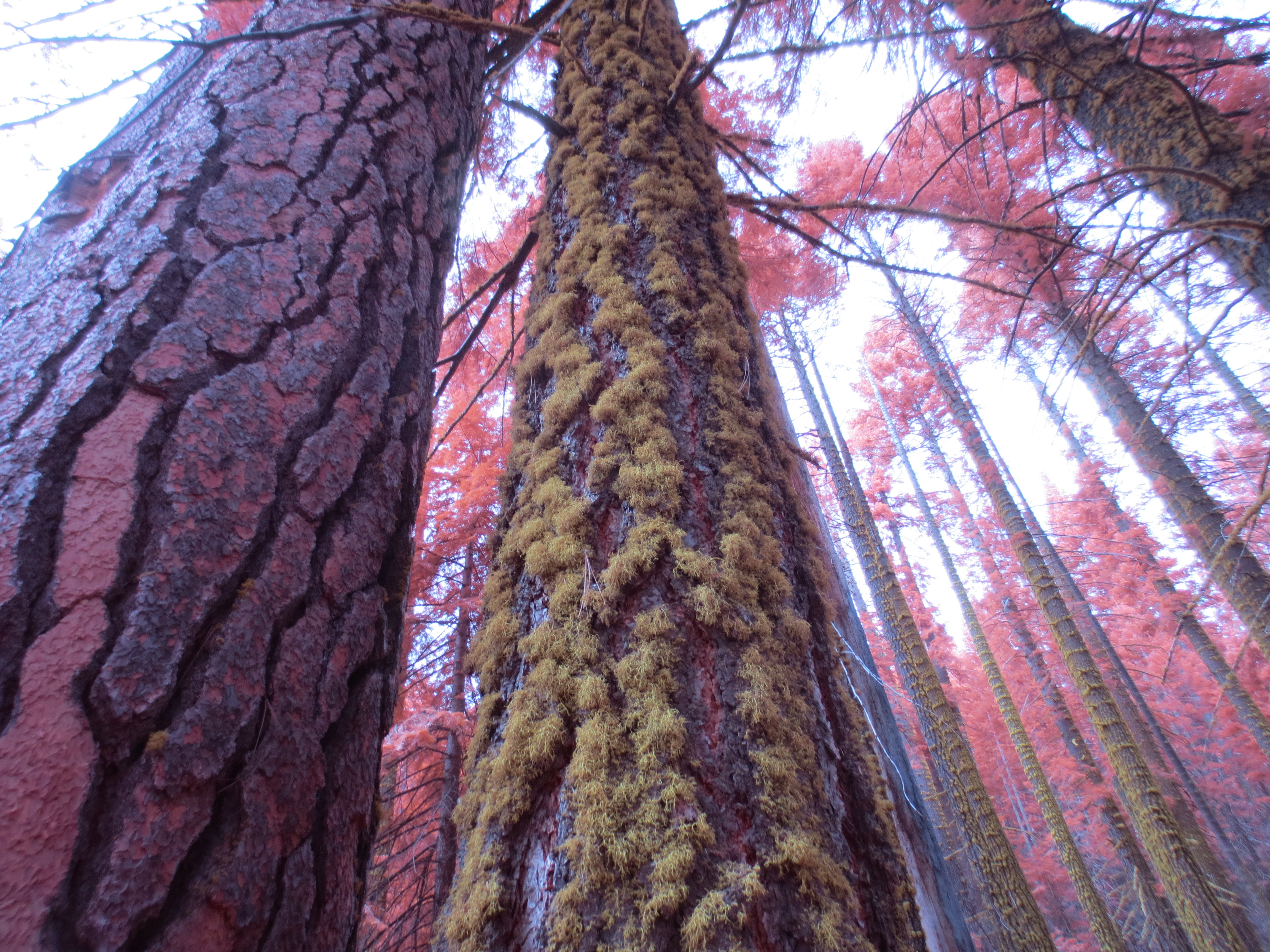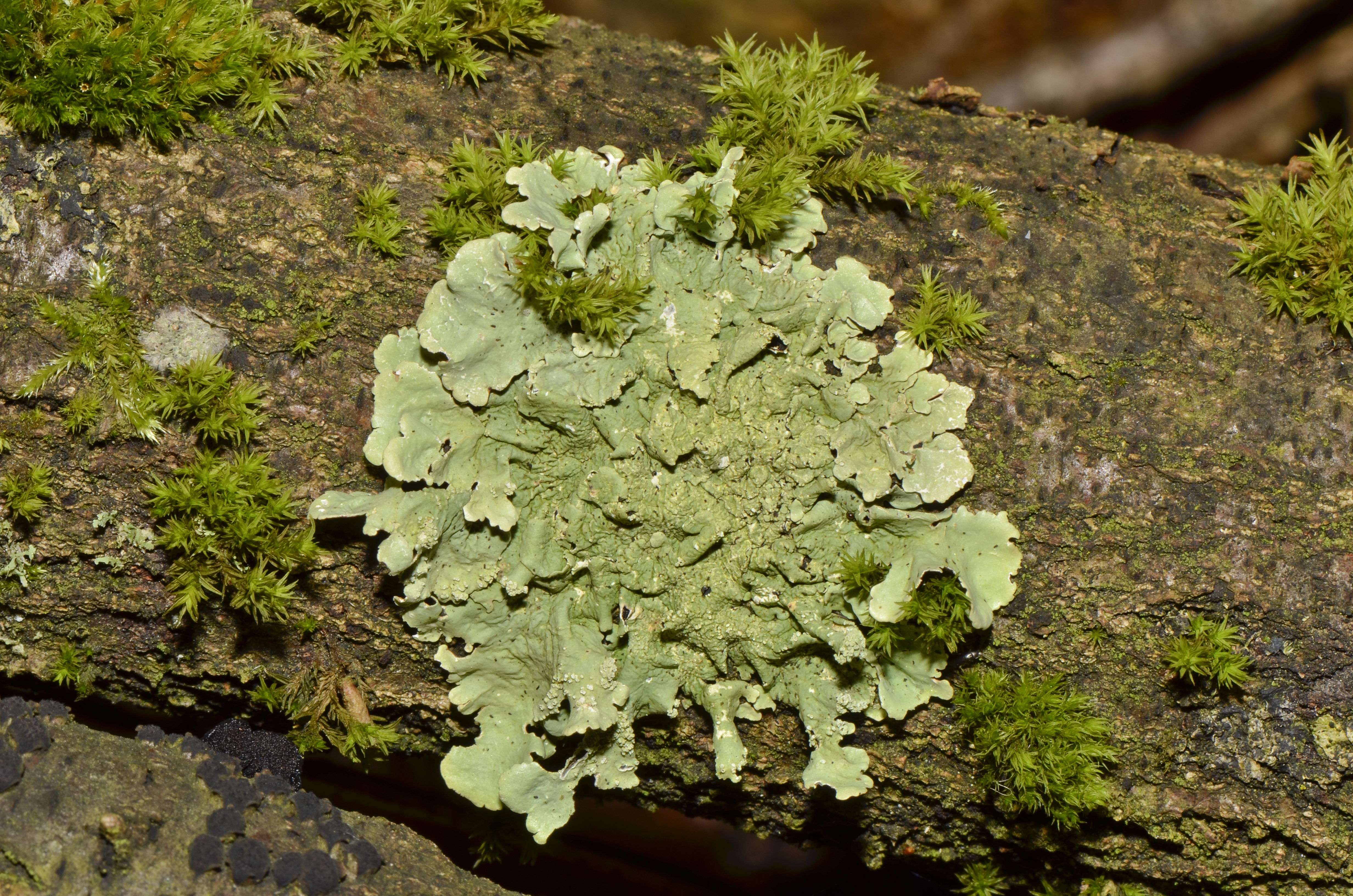|
Fruticose Lichens
A fruticose lichen is a form of lichen fungi that is characterized by a coral-like shrubby or bushy growth structure. It is formed from a symbiotic relationship of a photobiont such as green algae or less commonly cyanobacteria and one, two or more mycobionts. Fruticose lichens are not a monophyletic and holophyletic lineage, but is a form encountered in many classes. Fruticose lichens have a complex vegetation structure, and are characterized by an ascending, bushy or pendulous appearance. As with other lichens, many fruticose lichens can endure high degrees of desiccation. They grow slowly and often occur in habitats such as on tree barks, on rock surfaces and on soils in the Arctic and mountain regions. Characteristics Fruticose lichens are lichens composed of a shrubby or bushy thallus and a holdfast. The thallus is the vegetative body of a lichen that does not have true leaves, stems, or roots. The thallus colour is affected by the algae in the lichen, compounds created by t ... [...More Info...] [...Related Items...] OR: [Wikipedia] [Google] [Baidu] |
Letharia Vulpina JHollinger Crop
''Letharia'' is a genus of fruticose lichens belonging to the family Parmeliaceae. There were historically two species of ''Letharia'': '' L. vulpina'' and '' L. columbiana''. Recent molecular sequence studies published in 2016 confirm at least 6 species in Western North America alone, with more expected to be confirmed using similar methods in other parts of the world. The typical photobiont is a green alga of genus ''Trebouxia ''Trebouxia'' is a unicellular green alga.Silverside, A. J. (2009). Retrieved from http://www.bioref.lastdragon.org/Chlorophyta/''Trebouxia''.html It is a photosynthetic organism that can exist in almost all habitats found in polar, tropical, a ...''. References Parmeliaceae Lecanorales genera Lichen genera Taxa named by Theodor Magnus Fries Taxa described in 1871 {{Parmeliaceae-stub ... [...More Info...] [...Related Items...] OR: [Wikipedia] [Google] [Baidu] |
Cortex (botany)
In botany, a cortex is an outer layer of a stem or root in a vascular plant, lying below the epidermis but outside of the vascular bundles. The cortex is composed mostly of large thin-walled parenchyma cells of the ground tissue system and shows little to no structural differentiation. The outer cortical cells often acquire irregularly thickened cell walls, and are called collenchyma cells. Plants Stems and branches In the three dimensional structure of herbaceous stems, the epidermis, cortex and vascular cambium form concentric cylinders around the inner cylindrical core of pith. Some of the outer cortical cells may contain chloroplasts, giving them a green color. They can therefore produce simple carbohydrates through photosynthesis. In woody plants, the cortex is located between the periderm (bark) and the vascular tissue (phloem, in particular). It is responsible for the transportation of materials into the central cylinder of the root through diffusion and may als ... [...More Info...] [...Related Items...] OR: [Wikipedia] [Google] [Baidu] |
Peltigerales
Peltigerales is an order of lichen-forming fungi belonging to the class Lecanoromycetes in the division Ascomycota. The taxonomy of the group has seen numerous changes; it was formerly often treated as a suborder of the order Lecanorales. It contains two suborders, eight families and about 45 genera such as ''Lobaria'' and ''Peltigera''. The fungi form lichens in a symbiotic relationship with one or two photosynthetic partners which may be a cyanobacterium such as ''Nostoc'' or a green alga such as '' Coccomyxa''. The majority of species contain just a cyanobacterium, a smaller number have both a cyanobacterium and a green alga while only a few species have just a green alga. The thallus of the lichen may be foliose (leafy), subfruticose (somewhat shrubby) or granular-squamulose (scaly). The thallus attaches to a surface by means of small root-like rhizines. In some species, the thallus may vary in appearance depending on whether it contains a cyanobacterium or a green alga. Some ... [...More Info...] [...Related Items...] OR: [Wikipedia] [Google] [Baidu] |
Lecanorales
The Lecanorales are an order of mostly lichen-forming fungi belonging to the class Lecanoromycetes in the division Ascomycota. The order contains 26 families, 269 genera, and 5695 species. Families * Aphanopsidaceae * Biatorellaceae * Brigantiaeaceae * Bruceomycetaceae * Carbonicolaceae * Catillariaceae * Cladoniaceae * Crocyniaceae * Dactylosporaceae * Gypsoplacaceae * Haematommataceae * Lecanoraceae * Malmideaceae * Pachyascaceae * Parmeliaceae * Pilocarpaceae * Psilolechiaceae * Psoraceae * Ramalinaceae * Ramboldiaceae * Scoliciosporaceae * Sphaerophoraceae * Stereocaulaceae * Tephromelataceae * Vezdaeaceae Genera of uncertain placement There are several genera in the Lecanorales that have not been placed with certainty into any family. These are: *'' Coronoplectrum'' – 1 sp. *'' Ivanpisutia'' – 1 sp. *'' Joergensenia'' – 1 sp. *'' Myochroidea'' – 4 spp. *'' Neopsoromopsis'' – 1 sp. *''Psoromella ''Psoromella'' is a genus of lichenized fungi ... [...More Info...] [...Related Items...] OR: [Wikipedia] [Google] [Baidu] |
Candelariales
The Candelariales are an order of fungi in the monotypic class Candelariomycetes. It contains the families Candelariaceae and Pycnoraceae. The order was circumscribed by Jolanta Miadlikowska, François Lutzoni, and Helge Thorsten Lumbsch as part of a comprehensive phylogenetic In biology, phylogenetics (; from Greek φυλή/ φῦλον [] "tribe, clan, race", and wikt:γενετικός, γενετικός [] "origin, source, birth") is the study of the evolutionary history and relationships among or within groups o ... classification of the kingdom Fungi published in 2007. The class Candelariomycetes was created in 2018 by Hermann Voglmayr and Walter Jaklitsch. References Candelariales Ascomycota orders Lichen orders Taxa described in 2007 Taxa named by Helge Thorsten Lumbsch {{Ascomycota-stub ... [...More Info...] [...Related Items...] OR: [Wikipedia] [Google] [Baidu] |
Baeomycetales
The Baeomycetales are an order of mostly lichen-forming fungi in the subclass Ostropomycetidae, in the class Lecanoromycetes. It contains 8 families, 33 genera and about 170 species. As a result of molecular phylogenetics research published in the late 2010s, several orders were folded into the Baeomycetales, resulting in a substantial increase in the number of taxa. Taxonomy The family Baeomycetaceae was originally proposed by Barthélemy Charles Joseph Dumortier in 1829 (under the spelling ''Baeomyceae''); he included two genera, ''Baeomyces'' and ''Calicium''. Baeomycetaceae was initially classified in the Lecanorales, and Baeomycetaceae and Cladoniaceae were thought to be closely related, sharing a phylogenetic origin in Lecideaceae. It was transferred to the order Helotiales based on the structure of its ascus, which is similar to those in genus '' Leotia''. However, the Helotiales consists of mostly non-lichenised fungi. The first DNA studies conducted with ''Baeomyces ... [...More Info...] [...Related Items...] OR: [Wikipedia] [Google] [Baidu] |
Arthoniales
The Arthoniales is the second largest order of mainly crustose lichens, but fruticose lichens are present as well. The order contains around 1500 species, while the largest order with lichenized fungi, the Lecanorales, contains more than 14000 species. Classification The Arthoniales is one of two orders of the class Arthoniomycetes within the phylum Ascomycota. The order includes seven families ( Andreiomycetacae, Arthoniaceae, Chrysotrichaceae, Lecanographaceae, Opegraphaceae, Roccellaceae and Roccellographaceae). Lecanographaceae, Roccellographaceae, Opegraphaceae and Roccellaceae are well-supported families within Arthoniales, and they were circumscribed in 2011. Andreiomycetaceae was described as a new family by Hodkinson and Lendemer in 2013. The Arthoniales is the sister group to Dothideomycetes. Figure 1. Cladogram of the Arthoniales, rooted with ''Curvularia brachyspora'', ''Cudonia circinans'' and ''Seynesia erumpens'' as the outgroup. The cladogram shows the ... [...More Info...] [...Related Items...] OR: [Wikipedia] [Google] [Baidu] |
A Guide To The Study Of Lichens (1904) (14744008916)
A, or a, is the first letter and the first vowel of the Latin alphabet, used in the modern English alphabet, the alphabets of other western European languages and others worldwide. Its name in English is ''a'' (pronounced ), plural ''aes''. It is similar in shape to the Ancient Greek letter alpha, from which it derives. The uppercase version consists of the two slanting sides of a triangle, crossed in the middle by a horizontal bar. The lowercase version can be written in two forms: the double-storey a and single-storey ɑ. The latter is commonly used in handwriting and fonts based on it, especially fonts intended to be read by children, and is also found in italic type. In English grammar, " a", and its variant " an", are indefinite articles. History The earliest certain ancestor of "A" is aleph (also written 'aleph), the first letter of the Phoenician alphabet, which consisted entirely of consonants (for that reason, it is also called an abjad to distinguish it fro ... [...More Info...] [...Related Items...] OR: [Wikipedia] [Google] [Baidu] |
Foliose
Foliose lichen is one of the morphological classes of lichens, which are complex organisms that arise from the symbiotic relationship between fungi and a photosynthetic partner, typically algae. This partnership allows lichen to live in diverse climates that can range from cold, dry mountains to wet, warm valleys. Lichens develop quite slowly with recorded growth rates of 0.01–27mm/year depending on the species. Their lifespan averages between 30 and 60 years. Lichens have a main body part called the thallus, which is composed of hyphae, and houses the cortex and medulla. The cortex contains the photosynthetic cells while the medulla allows for gas exchange and makes up the bulk of the lichen's thallus. There are three main types of lichens: crustose, foliose, and fruticose. Foliose lichen are characterised by flattened leafy thalli, and an upper and lower cortex. Many have numerous layers, which are stratified, and aid in identifying different types. Foliose lichens attach to ... [...More Info...] [...Related Items...] OR: [Wikipedia] [Google] [Baidu] |
Pycnidium
A pycnidium (plural pycnidia) is an asexual fruiting body produced by mitosporic fungi, for instance in the order Sphaeropsidales ( Deuteromycota, Coelomycetes) or order Pleosporales (Ascomycota, Dothideomycetes). It is often spherical or inversely pearshaped ( obpyriform) and its internal cavity is lined with conidiophores. When ripe, an opening generally appears at the top, through which the pycnidiospore {{Short pages monitor [Baidu] |
Perithecium
An ascocarp, or ascoma (), is the fruiting body ( sporocarp) of an ascomycete phylum fungus. It consists of very tightly interwoven hyphae and millions of embedded asci, each of which typically contains four to eight ascospores. Ascocarps are most commonly bowl-shaped (apothecia) but may take on a spherical or flask-like form that has a pore opening to release spores (perithecia) or no opening (cleistothecia). Classification The ascocarp is classified according to its placement (in ways not fundamental to the basic taxonomy). It is called ''epigeous'' if it grows above ground, as with the morels, while underground ascocarps, such as truffles, are termed ''hypogeous''. The structure enclosing the hymenium is divided into the types described below (apothecium, cleistothecium, etc.) and this character ''is'' important for the taxonomic classification of the fungus. Apothecia can be relatively large and fleshy, whereas the others are microscopic—about the size of flecks of ... [...More Info...] [...Related Items...] OR: [Wikipedia] [Google] [Baidu] |
Apothecium
An ascocarp, or ascoma (), is the fruiting body ( sporocarp) of an ascomycete phylum fungus. It consists of very tightly interwoven hyphae and millions of embedded asci, each of which typically contains four to eight ascospores. Ascocarps are most commonly bowl-shaped (apothecia) but may take on a spherical or flask-like form that has a pore opening to release spores (perithecia) or no opening (cleistothecia). Classification The ascocarp is classified according to its placement (in ways not fundamental to the basic taxonomy). It is called ''epigeous'' if it grows above ground, as with the morels, while underground ascocarps, such as truffles, are termed ''hypogeous''. The structure enclosing the hymenium is divided into the types described below (apothecium, cleistothecium, etc.) and this character ''is'' important for the taxonomic classification of the fungus. Apothecia can be relatively large and fleshy, whereas the others are microscopic—about the size of flecks ... [...More Info...] [...Related Items...] OR: [Wikipedia] [Google] [Baidu] |



.jpg)

